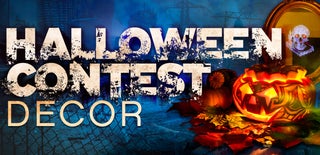Introduction: TV Wall of Terror
For a Halloween Party, I designed a semi-interactive, never-the-same-twice video wall featuring horrible images of extreme close-ups of eyes and a mouth.
The multiple monitors are driven by custom-designed video DVDs and a live video camera feed adds an interactive element.
Step 1: Tools and Materials
This is a pretty straight-forward project in terms of construction. It's simply a temporary arrangement of video screens, covered to look nice. Assuming you already have some shelves, there's really no construction involved.
You will need:
- Multiple television monitors (I used eleven)
- Video cables (Composite, with either RCA or BNC connections as needed)
- RCA to BNC adapters (optional, if needed)
- Video Camera & Tripod (Any format. Only needs a live video out.)
- Black Paper
- Black Cloth
- Black Tape
- Extension cords
- Power Strip
- Custom DVD video discs of the visual content.
Step 2: Video Shooting and Editing
To start with, I needed the extra-creepy video that I would display on the monitors.
I got the aid of my brother-in-law (whose house the party was at,) to be my actor.
I set up the camera on the tripod, zoomed all the way out, and set the focus to "Macro". This allows me to focus on objects extremely close up, even closer than the human eye can focus on. In this way, I can create video of a face that is unnaturally close.
I had the actor rest his chin on an adjustable height stand, and had the camera on a tripod to absolutely minimize camera and subject movement. Then, I had the actor follow some simple directions - look left, look right, blink, etc., filming for several minutes. I only filmed the one eye. I would use a "flop" mirroring special effect in the video editing software to create the other eye.
Next, I filmed his mouth in a similar way to the eye.
Once filmed, I brought the video into editing software on my computer. I trimmed the video to just the best parts, and copied and pasted several times to lengthen the total video.
I added a few special effects, including a vignette (to darken the edges of the screen) a resize (to make the eye and mouth best fill the screen) and a "Bad TV" effect (which added scan lines and waviness.)
The finished video was about nine minutes long. I exported it to DVD format and designed the DVD for "auto play" and "loop to the beginning". Instead of having a menu, the video will play automatically when put in the DVD player, and would automatically loop to the beginning when done.
For the "other eye", I duplicated the original eyeball video, but applied a mirror effect (to create a left eye from the right eye.) I also re-ordered some sections of the video and shortened it a bit. That would make sure that the two eyeballs would be random to each other, instead of accidentally in sync. With the videos two different loop times, they would naturally be changing the entire evening as the videos ran.
I edited the mouth video the same, sizing it to fill the 4:3 standard-definition frame, and creating an auto-looping DVD.
Step 3: Arrange the Monitors and Camera
Cathode Ray Tube video monitors seem to be going the way of the dinosaurs. The upside of it is that there are plenty of free monitors around if you have a use for them. In this case, I had a number of free monitors that originally came from a television station. They are monochrome, and several of them had bad "burn in". These were in a pile to go out to be recycled, so I salvaged them for this project, and will recycle them later.
The monitors are 8" "cube monitors" that use composite video connections. The connection is BNC, a twist-lock connector used on professional video equipment. The monitors also have the ability to pass through a video signal, allowing one video source to be connected to several monitors at once.
The area that this project was installed in is a hallway with some shelving used for storage.
I stacked the video monitors on the shelving in an array two high by four wide. I also had a color triple monitor that I set on the shelf below the others.
All the power cables were brought around to one side and connected to a power strip and plugged into wall power.
The video camera was set up on the tripod above the monitors, and angled down towards where viewers of the screen would be.
The three DVD players were stacked on the shelf to the left of the monitors.
Step 4: Wiring
Next, I completed all the cabling for power and video signals.
Power is easy, just plug all the monitors, the video camera, and the DVD players into a power strip and into wall power.
All three DVD players were connected to the monitors, using the plain composite video out. The players use RCA connections, and the monitors use BNC, so I connected them with a combination of cables and adapters as needed.
I used my own DVD player, a borrowed DVD player, and a car DVD player.
I planned out which video monitors I wanted each video source to run to, and then connected them in such a way that the video signals were "randomly" arranged. I didn't have any two monitors with the same signal either directly above, below, or next to the same image. I did specifically lay out the cabling so that the "Eyes" videos would be ABOVE the "Mouth" video.
The exception to that was the color triple monitors, which I ran the same signal to all three for repetition.
When possible, it's nice to use COLOR CODED cables. Multiple all black cables in a dark space are hard to use to trace video signals. Using different colors makes it much each to visualize the signal path. Using colored tape or colored Post-It's is also a nice simple way to organize cables and where the signals are running.
Frankly, the hardest part of the project was making the connections on the back of the monitors, having to reach over behind them. If you have a shelf where you can access the monitors from behind, it makes completing the connections much easier.
Step 5: Masking the Monitors
To complete the effect, everything EXCEPT the monitors needs to be covered.
In this hallway, most of the shelves are already covered with black packing blankets.
To cover the monitors, I used some old "seamless paper". This is a wide roll of paper used as a photographic back-drop. It was already dirty and torn, so I didn't feel like I was wasting paper.
I taped the black paper to the top of the shelves, then unrolled the paper to the floor. The extra paper just stayed rolled up on the cardboard tube, on the floor, right next to the base of the shelving.
I pressed the paper against the monitors to feel their outline, and then cut through the paper with a knife around the monitors.
Next, I used black tape to tape the paper to the edges of the monitors.
The video camera is above the top of the paper, so it can still see people looking at the monitors. I wrapped black cloth around the tripod to cover it up as well. In the dark, it is surprisingly hard to see the camera.
Step 6: Lights and Sound
No decor is complete without considering lighting and sound.
The black hallway is lit with "black-lights". These are fluorescent lights that give off mostly ultraviolet light. Black things stay very black, while white or neon object glow brightly. (Also, tonic water. Gin & Tonic is the best drink under a black-light….)
Four 4-foot T-12 tubes lit the middle of the hall, with a compact fluorescent backlight at either end.
For sound, a large stereo was placed at the end of the hallway, playing loud techno/dance music. Knowing that music was going to be played, I intentionally never designed audio to go with Wall of Video of Terrors. It is a visual effect only.
Step 7: PARTY!
There were just a few finishing touches to the project.
Of course, all the lights were off, except the black lights.
On the wall opposite of the monitors, we added a few items that would glow nicely from the black lights. This included some spider-webs, skeletons, and a scary face made from neon tape. Those elements would show up nicely on the monitor showing the feed from the video camera.
On the monitors themselves, I made a few tweaks. I varied the brightness and contrast to make it different from one monitor to the next. I also adjusted the vertical hold on one monitor to give a slow roll. Even monitors getting the same signal would look a little different depending on the individual monitor adjustment.
On the main array of eight monitors, I did NOT adjust the color. Some of the monitors naturally had more of a gray color, and some were more blue. They were just different monitors. I did make sure to put the two "gray" monitors next to each other to better match up the main eyes.
The triple monitor was the only one in color. On that one, I adjusted the hue and saturation from one screen to the next, making the middle one bright red, and one of the others a greenish tint. It made for a frightening Pop Art effect.
I simply put the DVDs into the players. They played automatically and looped all evening. The videos were intentionally non-synced, so the eyes and mouth were continuously moving differently, making sometimes frightening, sometimes humorous faces, but always very creepy and disturbing.
Costumed party guests were lit up by the backlight and usually made large motions to see themselves on the screen. The combination of live and extremely close-up pre-recorded video made for a fun, yet uncomfortable time - the way a good scare should be!

Participated in the
Halloween Decor Contest

Participated in the
Wall Overhaul

Participated in the
Make it Glow!













